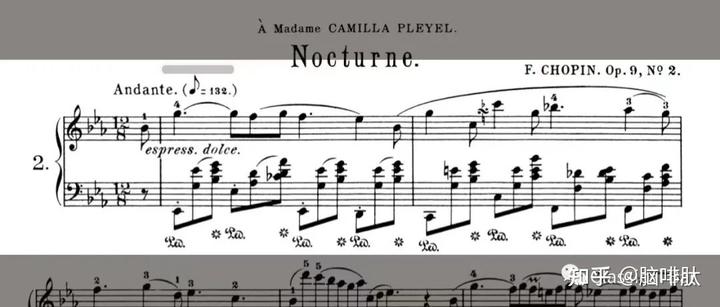|「夜曲」意境深邃、充满浪漫与梦幻, 是写满夜空的浪漫诗曲欢迎来到新的一期也是第一期「音乐专辑」之「夜曲」在接下来的几期里,让我们聊一聊萧邦和他的夜曲吧。
With deep artistic conception, full of romance and fantasy, Nocturne is piece of romantic poem written in the dark night.
Welcome to our new and first episode of 「Nocturne」 in「Music Album」!In the next few episodes, let's talk about Chopin and his Nocturnes.

谈及萧邦(F.F.Chopin,1810-1849),相信大多数人会想起夜曲9之2开头并且流淌在整首乐曲间的旋律Speaking of Chopin (F.F. Chopin, 1810-1849), I believe that most people will think of the melody at the beginning of nocturne 9 of 2 that flows through the whole piece:

同样,谈起夜曲,我们最先想到的也很可能是萧邦。是的,夜曲,可以说是萧邦最为出名的一系列作品,他们优美的旋律使之成为古典音乐中比较容易入门的一系列作品,“萧邦”与“夜曲”也可以说互为代名词。但是,夜曲是萧邦的独创吗?
Meanwhile, when we talk about nocturnes, the first impression in out mind might be Chopin. To be honest, nocturne could be said as one of Chopin's most famous series of works. Their beatiful melody makes it easier for people to be introduced to Classical music. "Chopin" and "Nocturne" can also be considered to be synonymous with each other. Was Nocturne, however, Chopin's original works?
实际上,夜曲源自爱尔兰作曲家约翰‧菲尔德(John Field,1782-1837),一位古典主义与浪漫主义交接时期的作曲家。在菲尔德的笔下,夜曲就如他的名字一样,适合在夜里弹奏,带听者融入到澄澈的,美好的夜晚。流露出田园的美好,好像清澈的空气飘荡在晚空中。他们通常简单朴素,右手优美的旋律配上左手朴素的伴奏,如同入夜时分简单的独白。但菲尔德的夜曲有时会被认为比较保守而简单。In fact, nocturnes originated from Irish composer John Field (1782-1837), a composer of the transitional period between classicism and romanticism. In Field's hands, nocturnes are, as the name suggests, perfect for playing at night, bringing the listeners into a clear, beautiful night. Exuding the beauty of the pastoral, as if the clear air is floating in the evening sky., they are often quite simple. With the beautiful melody of the right hand and the simple accompaniment of the left hand, Field's nocturnes are like simple soliloquy at night. But they are sometimes considered conservative and simple.
萧邦呢,则将自己擅长的,华美的、如歌般的装饰音融入了夜曲。同时为其注入了具有歌唱性的旋律以及波兰民族音乐特征,使得肖邦夜曲不但成为夜曲的代名词,而且至今仍是古典音乐里最受欢迎的曲目之一。「夜曲」的创作几乎贯穿了萧邦的整个创作生涯,1827-1846。从他早期模仿与继承菲尔德的夜曲风格所作的Op.9之1、2,到他暮年创作的凄美挽歌——Op.62。21首《夜曲》是心灵的自画像,暗流激荡,充满幻想。有着最柔美的黑,最刺眼的亮,最激动的波涛,和最凄凉的叹惘。
Chopin, on the other hand, incorparated the beautiful, cantabile grace notes which he was good at into nocturnes. At the same time for its injection of singing melody and the characteristics of Polish folk music, making Chopin's nocturnes not only become synonymous with nocturne, but also still one of the most popular classical music tracks. The composition of "nocturne" almost ran through Chopin's entire creative career, 1827-1846. From his early imitation and inheritance of Field's nocturne style in Op.9 no.1&2, to his late years of poignant elegy -- Op.62. The 21 nocturnes are a self-portrait of the soul, stirring and full of fantasy. The softest black, the most dazzling light, the most excited scream, and the most desolate sigh.
Op.9 no.1/Op.9 no.2
Nocturne in B -flat Minor. Op. 9/1 (降B小调夜曲,作品9第1首)音乐:Arthur Rubinstein;Frédéric Chopin - Chopin: Nocturnes
Nocturne in E-flat, Op. 9/2 (降E大调夜曲,作品9之2)音乐:Arthur Rubinstein;Frédéric Chopin - Chopin: Nocturnes
Op.9的前两首夜曲,降B小调以及降E大调,是这一夜曲系列(18首夜曲,并不包括生前未出版的遗作)中最广为人知的作品。这三首夜曲作于1830-1832年,标题是“献给波列意夫人”, 这两首乐曲在风格上并没有脱离菲尔德的很安静,沙龙的风格。但萧邦并没有满足于简单的旋律,而是在两首作品中融入了意大利歌剧的美声元素,换一种说法就是,加入了大量装饰性的旋律,例如在夜曲9之1开头的11连音接22连音.
很多学钢琴的朋友可能会苦恼于这样的33连音:我该如何把左手和右手合起来呢?我也有这样的疑惑。答案其实很简单,那就是:不合起来。这样的自由速度在萧邦作品中非常常见,也是萧邦作品最美的元素之一。左手像是规律的伴奏,右手则像花腔女高音,自由的歌唱着弹性速度(Rubato)。b站上的一位up主,@安迪老师,的一个比喻非常形象:你去听音乐会,在门口看到一位非常漂亮的女孩子/帅哥,ta还没有进门,进去你俩就见不到了,所以你得在ta进门之前“偶遇”ta。此时ta离门口还有6步,而你还有11步。你得追上ta,但又不能让ta察觉出你的意图。所以你需要悠闲地走过去,恰好在ta走完六步时追上ta。
回到正题,萧邦夜曲Op.9 刚出版时,却收到了一些批评的声音,例如德国乐评家列尔斯塔称这套夜曲较菲尔德的有欠自然,装饰音则像加入了过多“香料和胡椒”。
The first two nocturnes of Op.9, in B-flat minor and E-flat major, are the most well-known works of this nocturne series (18 nocturnes, excluding unpublished posthumous works). These nocturnes, composed in 1830-1832 and titled "To Madame de Boregier", do not stylistically depart from Field's very quiet, salon style. Since Chopin was not satisfied with simple melodies, he incorporated the bel canto elements of Italian opera into the his works. In other words, he added a lot of decorative melodies, such as the 11th legato at the beginning of Nocturne 9-1. Connected with a 22 Legato:
When Chopin's Nocturne Op.9 was first published, it received some criticism. For example, German music critic Lierstad said that this Nocturne was less natural than Feld, and the ornaments seemed like adding too much "spice and pepper".
我相信萧邦是绝对不会温驯地步入良夜的。当你以为萧邦与他的听者会随着Op.9 的前两首夜曲走进美好的梦乡之时,Op.9 之3给了我们一个惊喜,安插在曲中的突然而至的“拍打着窗户的大雨”骤然把我们从睡梦中惊醒。而在Op.15三首夜曲中,萧邦带给我们的则是一场午夜的不安……
I am sure that Chopin would never go into a good night meekly and gentlely. Just when you thought Chopin and his listeners would fall asleep with the first two nocturnes of Op.9 sweetly , Op.9 No. 3 gave us a surprise, the sudden "beat" inserted in the song. "Heavy rain on the window" suddenly woke us up from our sweet dreams. And in the three nocturnes of Op.15, Chopin brought us a midnight nightmare...
Op.15 no.1/Op.15 no.3
Nocturne in F, Op. 15/1 (F大调夜曲,作品15第1首)音乐:Arthur Rubinstein;Frédéric Chopin - Chopin: Nocturnes
有人曾形容F大调夜曲Op.15 no.1的开头,左手装饰性的三连音像是肖邦用柔软的蝴蝶翅膀刷出来的主题。若即若离的声部是否暗示了萧邦与故乡的分离,隐隐地表达了萧邦的思乡之情?纯属猜测。但随着这段柔软的旋律的结束,一次惊心动魄的噩梦出现了,这毫无预兆的”暴风雨“的到来着实吓了很多听众(包括我)一跳。随着暴雨的过去,音乐又回到了一开始平静的旋律直至曲终。这样的结构常常被称为单三部曲式(A B A’),而B段出现一次次的噩梦在萧邦接下来的夜曲中逐渐成为常态,例如Op.27之1。
从早期创作的通常被认为是夜晚的情歌,菲尔德的传承,舒缓,宁静,而又浪漫的Op.9 no.1 no.2,到在Op.9 no.3中间的B段穿插一段“大雨”,再到Op.15 no.1 中的噩梦,萧邦的转变是明显的。到F大调夜曲15之1,萧邦似乎已经完全从菲尔德的框架中跳脱出来,赋予了夜曲全新的意义,同时将浓烈的情感交织在一首首夜曲中。而到了夜曲15之3,萧邦再一次突破,将类似玛祖卡舞曲的旋律带入到夜曲中,这听起来很奇怪:怎么可以在夜晚的乐曲中加入舞曲的元素呢?萧邦他的确这样做了,而且将这首曲子描绘成了戏剧性,有点悲伤的乐章。值得注意的是,曲子的终止是以B段的结束为标志,而非回到A段,形成三段结构:
Nocturne in G Minor, Op. 15/3 (G小调夜曲,作品15第3首)音乐:Arthur Rubinstein;Frédéric Chopin - Chopin: Nocturnes
萧邦在创作这首夜曲的一段时间里,曾多次欣赏过莎士比亚的作品,包括悲剧,哈姆雷特;据说,他还打算为这首夜曲起一个标题,叫《哈姆雷特观后感》,但为了让听众自己想象,便作罢。
Someone once described the opening of Nocturne in F major, Op.15 no.1, with the ornamental triplets on the left hand as a theme painted by Chopin with the soft butterfly wings. Does the elusive harmony imply the separation of Chopin from his hometown, and vaguely express Chopin's homesickness? Only based on speculation. But with the end of this soft melody, a thrilling nightmare emerged, and the arrival of this unpredictable "storm" really startled many listeners (including me). As the rainstorm passed, the music returned to a calm melody at the beginning until the end. Such a structure is often referred to as a single trilogy (A B A'), and the recurring nightmare of the B section gradually becomes the norm in Chopin's subsequent Nocturnes, such as Op. 27 No. 1.
From the early love poems singing at night , a kind of inheritance to Field, and the soothing, tranquil, and romantic Op.9 No.1 & No.2, to the "heavy rain" inserted in the middle B of Op.9 No.3, finally to the nightmare in Op.15 No.1, Chopin's transformation is evident. When it comes to nocturne 15-1 in F major, Chopin seems to have completely broken away from Field's framework, giving a whole new meaning to nocturne and interweaving strong emotions into one nocturne after another. By nocturne 15-3 Chopin once again made a breakthrough and introduced a mazurka-like melody to this nocturne, which seemed strange: how could the elements of dancing music be added into a night piece? While, Chopin really did, and he painted it as a kind of dramatic and sad piece. It is worth noting that the end of the piece is marked by the end of section B, rather than returning to section A, forming A three-section structure.
我们说,萧邦夜曲的创作是贯穿他的一生的,从他的作品的走向与风格的转变来看,的确如此。如果继续聆听萧邦接下来的夜曲作品,我们可以更加明朗的找到这一系列的脉络。
那么,今天这一期「音乐专辑 Op.1」之夜曲 no.1 第一期到这里就结束了,在接下来的几期里,我们会与您继续交流讨论萧邦中后期以及晚期的夜曲作品,也可能会提到其他作曲家的夜曲作品。
感谢您的陪伴,我们下期再见。
Bye~
文| 脑啡肽
译| 脑啡肽






